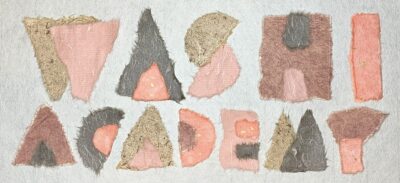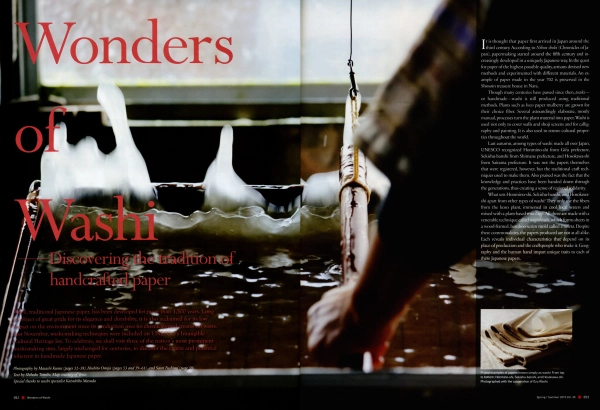Washi is featured in volume 35 (Spring/Summer 2015) of Kateigaho International Japan Edition, a luxurious, super-glossy magazine detailing different aspects of Japanese art and culture. The article is relatively brief, but is a mostly fine introduction to washi, especially for beginners. Unfortunately, there are a few factual errors and what I imagine are errors in translation, as the article was originally written in Japanese. It’s too bad, as the article has such potential and is accompanied by really beautiful photography.
The article is written in celebration of the fact that “last November [2014], washi-making techniques were included on UNESCO’s Intangible Cultural Heritage list.” This has been something of a big deal here, and I have failed to address it on this blog until now. I think it’s still too early to tell what kind of an impact the designation will have – if any – on local papermakers. I’d love for it to spark renewed interest in and increased use of washi both in Japan and internationally, but my instinct is that there will be a small bump in interest followed by a return to status quo (which is decidedly dire).
Because I did find errors, I need to fact-check the following before accepting them entirely, but these are some discovery points for me in the article:
In the section on Sekishu Banshi:
• “What characterizes this washi is its resistance to tearing, due to the long, thick fibers of the Sekishu kozo grown in local fields for three years before harvesting. The bark fibers have a robust yet pliant quality.” I’ve never heard of kozo being harvested after three years. Ganpi and mitsumata, after three to five (or more) years growth, but kozo, always after one. I wonder if the article is correct, as I would think that the fibre would be extremely tough and gnarly after three years. I have it on good authority that even the bark from the base of the plant after *one* year is sub-optimal in terms of its toughness and lack of pliancy (also that the top part of the plant is mostly useless, leaving the middle section as Grade AAA). Three-year kozo is a very interesting tidbit if it is true!
In the section on papers made across Japan:
• The number of papermaking studios in Japan is listed as “nearly 200”. The number I have heard over and over again here over the last 10+ years is “about 300,” though in recent years I have heard people begin to question that number as too high, so maybe this number is the new standard. The “washi specialist” listed for the article is someone I know and respect, so I have ultimate faith in the numbers, though it’s a bit depressing to think that the number has sunk that low.
• Mitsumata is translated as “paper birch.” This is the first time for me to see it translated this way. I suspect that this is likely an error, but I need to do some research!
And finally:
• “Geography and the human hand impart unique traits to each of these Japanese papers.” Nice turn of phrase.



I’ve been in Japan for a little bit now, yet to have seen anything like this.
Hi, Nihon Scope. Not sure what you haven’t seen… Washi? Kateigaho?
I’m embarrassed to say I’m not sure if I remember any of the names of >_< I've seen interesting pieces of paper in omiyage shops and one guy in Hakata was there showing off some tools and talking with everyone… which again went right over my head. Either way, very beautiful elegant pieces of art work.